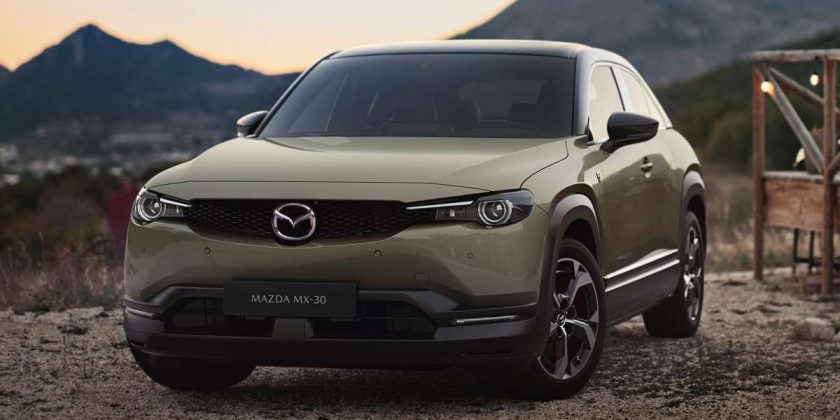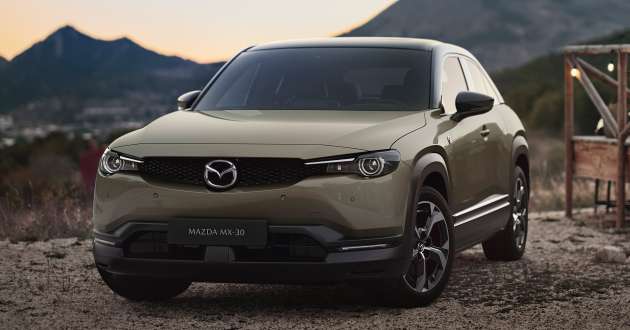Mazda has brought back the rotary engine, but not in the way you remembered it if you have fond memories of the past RX cars like the RX-3, RX-7 and RX-8. Instead, the rotary engine now serves as a generator in the new MX-30 R-EV, which made its debut at this year’s Brussels Motor Show.
Visually, the electric vehicle (EV) with a range extender doesn’t look very different from its full EV stablemate, with notable revisions being available wheel designs and the placement of new logos that is reminiscent of the three-sided Wankel rotor.
The new model will be available in ‘Edition R’ guise, which features a black-based exterior and Maroon Rouge Metallic interior trims as well as a remake of the roof color of Mazda’s first passenger vehicle – the Mazda R360 Coupe – as an exterior accent color. It also includes exclusive design elements such as a rotor-shaped emblem sewn into the floor mats and embossed on the seat headrests.
The rotary engine used is dubbed the 8C, and it has a capacity of 830 cc, with quoted outputs being 75 PS (74 hp or 55 kW) and 116 Nm of torque. The 8C is Mazda’s first production rotary engine since 2012 and features side intake and exhaust ports like the Renesis unit in the RX-8, although it does get direct fuel injection, an aluminium rotor housing and thicker apex seals of 2.5 mm.
Operating just to generate electricity and not to the drive the wheels, the petrol mill sits at the front and juices an underfloor-mounted lithium-ion battery with an energy capacity of 17.8 kWh. That’s half the capacity of the MX-30 EV’s battery, with Mazda quoting a combined all-electric range of just 85 km (110 km for city driving) following the WLTP standard.
Said figure is not particularly impressive, but that’s before accounting for the rotary engine supplying power to charge the battery on the move. The MX-30 R-EV has a 50 litre fuel tank, which should give it a substantial range advantage compared to its sibling – Mazda isn’t providing a total range figure just yet, but we’re told it’ll consume 1l/100 km of fuel.
The series hybrid system also has plug-in capability, and with the reduced battery capacity, it takes about 50 minutes to fully charge the battery with a maximum AC input of 11 kW (1.5 hours with 7.2 kW). As an alternative, there’s also DC fast charging at up to 36 kW (the MX-30 EV can do 50 kW) to go from a 20-80% state of charge in 25 minutes. There’s also a 1,500-watt auxiliary power port in the car should you want to power appliances.
Another unique feature of the MX-30 R-EV, aside from the reduced range anxiety, is the electric motor. With outputs of 170 PS (168 hp or 125 kW) and 260 Nm, there’s more horsepower but less torque when compared to the MX-30 EV’s 145 PS (143 hp or 107 kW) and 271 Nm.
Don’t expect a huge performance bump, as the 0-100 km/h sprint takes 9.1 seconds (MX-30 EV takes 9.7 seconds) and the top speed is still limited to 140 km/h. The fact that the MX-30 R-EV weighs 1,778 kg, or about 130 kg more than the full EV version, also contributes to these numbers.
Drivers will be have three modes for the e-Skyactiv R-EV powertrain at their disposal, with Normal generally operating like a regular EV, but will bring in the engine to maintain charge during high acceleration. Meanwhile, EV mode forces the car to run on electricity until the battery is depleted, or if the accelerator pedal is depressed far enough. Lastly, Charge mode lets driver set a battery level for the car to achieve and maintain it.
Source: Read Full Article







